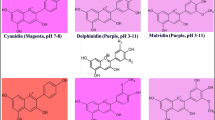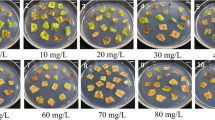Abstract
Miraculin is a taste modifying plant protein, which displays a peculiar property of being able to modify sour taste into sweet taste. Thus, there has been an increasing interest in miraculin due to this amazing property. In the present study, miraculin gene was introduced into the Miyagawa Wase Satsuma mandarin (Citrus unshiu Marc.) callus by Agrobacterum-mediated transformation to produce a citrus transgenic plant and express the recombinant miraculin protein under the control of 35S promoter. Satsuma mandarin is one of the choicest citrus varieties grown widely and commercially in Korea, especially in Jeju Island, and Japan. Expression of this protein in the transgenic plant resulted in the accumulation of a significant amount of the miraculin protein in the leaves. To investigate whether the expressed protein was correctly modified, the dimerization and N-glycosylation of recombinant miraculin in the transgenic plants were analyzed. The recombinant protein also showed a sufficient biological activity. These results open up a new way of expression system in woody plants such as citrus and can provide a suitable alternative for producing recombinant miraculin.
Similar content being viewed by others
References
Brouwer JN, Van der wel H, Francke A, and Henning GJ (1968) Miraculin, the sweetness-inducing protein from miracle fruit. Nature 220, 373–374.
Gibbs BF, Alli I, and Mulligan C (1996) Sweet and taste-modifying proteins: a review. Nur Res 16, 1619–1630.
Grosser JW, Ollitrault P, and Olivares-Fuster O (2000) Somatic hybridization in citrus: an effective tool to facilitate variety improvement. In Vitro Cell Dev Biol-Plant 36, 434–449.
Ito K, Asakura T, Morita Y, Nakajima K, Koizumi A, Shimizu-Ibuka A, Masuda K, Ishiguro M, Terada T, Maruyama J, Kitamoto K, Misaka T, and Abe K (2007) Microbial production of sensory-active miraculin. Biochem Biophys Res Comm 360, 407–411.
Jin SB, Song KJ, and Riu kZ (2007) Several factors affecting embryogenic culture maintenance and shoot regeneration in ‘Miyagawa Wase’ satsuma mandarin (Citrus unshiu). Hort Environ Biotechnol 48, 165–170.
Kurihara K and Beidler LM (1968) Taste-modifying protein from miracle fruit. Science 161, 1241–1243.
Kurihara Y (1992) Characteristics of antisweet substances, sweet proteins, and sweetness-inducing proteins. Crit Rev Food Sci Nutr 32, 231–252.
Kurihara Y and Nirasawa S (1997) Structures and activities of sweetness-inducing substances (miraculin, curculin, strogin) and the heat-stable sweet protein, mabinlin. FFI J Jpn 174, 67–74.
Matsuyama T, Satoh M, Nakata R, Aoyama T, and Inoue H (2009) Functional expression of miraculin, a taste-modifying protein in Escherichia coli. J Biochem 145, 445–450.
Stam M, Mol JNM and Kooter JM (1997) The silence of genes in transgenic plants. Ann Bot 79, 3–12.
Sugaya T, Yano M, Sun HJ, Hirai T, and Ezura H (2008) Transgenic strawberry expressing the taste-modifying protein miraculin. Plant Biotechnology 25, 329–333.
Sun HJ, Cui Ml, Ma B, and Ezura H (2006) Functional expression of the taste-modifying protein, miraculin, in transgenic lettuce. FEBS Letters 580, 620–626.
Sun HJ, Kataoka H, Yano M, and Ezura H (2007) Genetically stable expression of functional miraculin, a new type of alternative sweetener, in transgenic tomato plants. Plant Biotechnol J 5, 768–777.
Tarentino AL and Plummer Jr TH (1982) Oligosaccharide accessibility to peptide: N-glycosidase as promoted by protein unfolding regents. J Biol Chem 257, 10776–10780.
Theerasilp S and Kurihara Y (1988) Complete purification and characterization of the taste-modifying protein, miraculin, from miracle fruit. J Biol Chem 263, 11536–11539.
Author information
Authors and Affiliations
Corresponding author
Additional information
Md. Adnan Al Bachchu and Seong-Beom Jin contributed equally to this study.
Rights and permissions
About this article
Cite this article
Al Bachchu, M.A., Jin, SB., Park, JW. et al. Functional expression of miraculin, a taste-modifying protein, in Transgenic Miyagawa Wase Satsuma mandarin (Citrus unshiu Marc.). J. Korean Soc. Appl. Biol. Chem. 54, 24–29 (2011). https://doi.org/10.3839/jksabc.2011.003
Received:
Accepted:
Issue Date:
DOI: https://doi.org/10.3839/jksabc.2011.003




